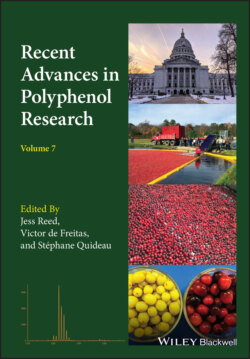Читать книгу Recent Advances in Polyphenol Research - Группа авторов - Страница 32
2.3.2 Retrosynthesis
ОглавлениеFigure 2.8 illustrates a synthetic analysis en route to the A‐type structure, focusing on the key dioxabicyclic skeleton. Three potential pathways are shown.
Route I is relevant to the Path I biosynthesis discussed in Section 2.3.1 (see Figure 2.7), disconnecting the C–O bond i in A to B with a single connection and the C(2) cation center, which could be traced back to a B‐type structure B' as a precursor. In executing the synthesis, this approach has an advantage, that the corresponding B‐type structures are synthetically well accessible (Ohmori et al. 2004, 2011; Oyama et al. 2008; Kozikowski and Tückmantel 2009; Saito et al. 2009; Yano et al. 2012; Makabe 2013). However, a concern is that the site‐specific oxidation at the C(2) benzylic center on the upper flavan unit may be challenging.
Figure 2.8 Retrosynthetic analyses of the A‐type structure.
Route II relies on the retrosynthetic hydrolysis of the acetal moiety in A. Dissection of the bonds i and ii suggests ketone C as the precursor. Assuming the Michael addition, ketone C is accessible by combining an electrophilic chalcone unit E and a nucleophilic flavan unit D. In this approach, rigorous stereocontrol at the Michael addition stage is necessary.
Route III corresponds to another biomimetic pathway (Path II, Figure 2.7), based on the two‐bond disconnection at bonds i and iii in A, assuming a formal [3+3]‐cycloaddition of a dicationic species F and a nucleophilic partner G. As the possible synthetic equivalents to the key dicationic species F, one could conceive flavylium salt F' or flavan unit F″ with two leaving groups at the C(2) and C(4) positions. This approach would realize direct conversion to the key bicyclic skeleton. If flavylium salt F' were used, the enantiocontrol would inevitably pose a serious problem. In contrast, use of the flavan unit F″ could achieve a stereoselective reaction, as will be discussed later (see Section 2.3.5).
